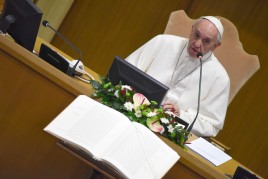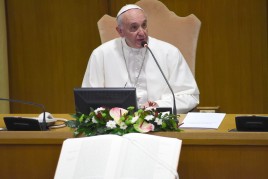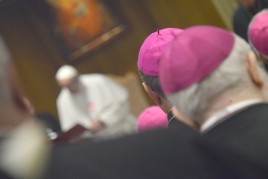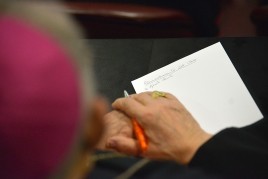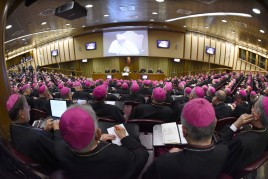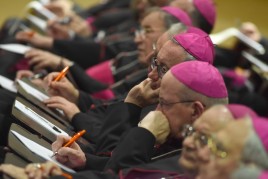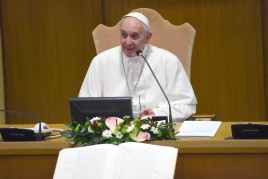
On Monday May 16 Pope Francis delivered his third opening address at the Italian Bishops Conference’s Assembly (CEI), dedicated this year to “Renewal of the clergy”, with the purpose of furthering lifelong formation. The Holy Father always surprises us, this time with a “reversed perspective.” Instead of offering a “systematic reflection on the figure of the presbyter” he invited us to “listen” calling upon the bishops to adopt a completive approach.
This could rightly be a first interpretative key:
namely, from an abstract moralist perspective to a concrete contemplative one.
Let us first of all listen to what the Pope says:
“Draw near, almost on tiptoe, to any of the many parish priests who devote themselves to our communities with the eyes of our heart, and ask yourself with simplicity: what gives flavour to his life? For whom and for what does he commit his service? What is the ultimate reason for his self-giving?”
There is an image at the centre: it’s the image of a parish priest, not an idealized priest, an abstract figure. He is simply a priest “who dedicates himself to our communities.” In his address, several times the Pope describes him as “our priest”, emphasizing the term “our.” This image recalls the image of the priest that all of us – priests and lay Catholics alike – cherish in our hearts, for he did good unto us at some stage of our lives. In this case the Pope evokes figures such as don Enrique Pozzoli (Salesian), or Roberto Iturrate (Jesuit) and others, mentioned in his publications. Bringing to our minds these images means recalling priestly vocation, when, observing a priest, we wish we could “age like him.” I wish I were like that priest (shunning things pertaining to someone else…). Thus Pope Francis describes “our priest”, inviting us to undertake
three contemplative steps.
First step: “to draw close” barefooted and on tiptoes (our priest is also barefoot), with the humility of someone who realizes he is being observed.
Second step: “to let his face be seen through the eyes of our heart.” Contemplating a priest who lets himself be worn out for his people is not a pleasant sight. It’s something different, like when we are looking at someone who is working hard, digging a well or running back and forth in a restaurant, or providing nursing assistance to patients in a hospital. Arduous work challenges us, and the Pope wants that bishops let themselves be challenged by the work of their priests.
Third step: questions. Contemplation in the Spiritual Exercises always become concrete in what the Lord wants me to do here and now.
- foto SIR/Marco Calvarese
- foto SIR/Marco Calvarese
- foto SIR/Marco Calvarese
The transcendent trait can be said to be
the second interpretative key of the Pope’s address.
The Pope simply asks what gives flavour to the life of our priest, where it comes from, what is its motivation. However, those are not “specific” questions. Rather, they are transcendent questions on the beauty of the priesthood, its ultimate good, its truth in the broadest sense of the term.
Beauty is not for our eyes to see, as said. Our priest might be tired, disheveled, and sometimes even grumpy. Not even he “sees” the beauty in the meanders of his daily work. But he feels Christ in everything he does…
Facing the second question: “to whose benefit does our priest offer his service”, the Pope again reverses the perspective. Before addressing himself to the recipients of his service, he “makes us feel what our priest feels”, namely, he feels he is a part of the Church, of her community, of the holy People of God, of his fellow priests. Before asking “for whom”, Francis asks “with whom” and “in whom.” He makes us enjoy the fact that we belong to people, not to things. This is evident in his concluding remarks, when Francis mentions economic structures and goods:
“Only keep what is required to foster the experience of faith and charity of the people of God”
Far from being a pastoral for the preservation of things, it is a pastoral care at the service of people that enable us to overcome our self-referentiality. The third question relates to “the reason for self-giving”, whose answer is the Kingdom. Indeed, in this case the vision of the Kingdom propounded by Francis has a wide horizon. It’s the “land visited every morning by God’s presence”, it’s the journey undertaken by “human history, despite the delays, the obscurities and the contradictions”; it’s the “vision Jesus has of man”, and through this joy “it allows him to relativize everything else.”
Finally, the Holy Father explains that he has “outlined” the threefold sphere of belonging that constitutes us as priests: belonging to the Lord that we delight in, to the Church, our possessed good, and belonging to the Kingdom, the horizon that illuminates and attracts us. “This treasure in earthen vessels must be protected and promoted.”
- foto SIR/Marco Calvarese
- foto SIR/Marco Calvarese
- foto SIR/Marco Calvarese
The third interpretative key of the speech seeks
to achieve a conversion in our way of thinking.
This conversion, which leads us to base our reasoning on man’s vision of Jesus, requires a change in the protagonism, rather than in the concepts. In fact, in the opening sentences it emerges that our glance is placed in the “right light” to contemplate the authentic figure of the priest. The Spirit, the protagonist of the history of the Church, must be allowed to be the protagonist of the longed for renewal of the clergy. This renewal also entails a generational aspect, as observed by the Holy Father at the beginning of his address, asking with joy the exact number of those newly appointed (over 36), for the Hall was pervaded by the “perfume of the charisma” of the recently ordained bishops.

